I am grateful to Bill Orzell for the excellent article shown below, part of his 'Jumping from Long Island to Westchester' and 'The New UBS Arena Has A Fine Pedigree' articles. He has also written articles on a number of former racecourses and important buildings associated with racecourses, including Belmont Park Terminal Racecourse & Bowman Park (Blind Brook).
Sporting venues which are operational across succeeding generations develop a special affinity with those who patronize the many performances at these special locales. These settings are more than just a point-of-interest on a geographic information system or map; instead, all the successes, failures and experiences combine with our psyche and heart strings into something more than physical and form an emotional legacy across the measure of time. Even the meccas of competition which have been lost to the ages stay with us as memories, or are revered by historic accounts into legend. Certainly the greater New York area has many such locations, with one of them being Belmont Park, and we will have a chance to witness the newest, in the Islanders new home at UBS Arena.
The Westchester Racing Association raced in that county at both Jerome Park and Morris Park, prior to those properties being annexed by the City of New York, and becoming an extension of the Bronx. The directors, when they began seeking a new racing location, responded to many of their participants already having vacation homes on Long Island, and they were led to the large outwash plain formed by the last glacier to cross the Empire State. The privately held Westchester Racing Association was able to acquire and cobble together several farm properties, the most notable being the former Oatlands Estate of William De Forest Manice. The new racing facility, which would become Belmont Park, was comprised of 400 acres north of the Hempstead Turnpike and 160 acres on the south side.
The Manice acreage acquired included an anglophile style manor house, thought at that time to be more than a century and a half old. The Manice Mansion, a palatial gray stone Tudor-Gothic edifice with nearly one hundred leaded glass windows and accompanying shutters, castellated turrets and quoin posts tapered to conical finials and a lofty square tower, fronted on Hempstead Turnpike. Mr. Manice was in the unique position as a global shipping magnate to collect plant specimens from around the world as a hobby, and place them in his own display. The structure was surrounded by magnificent gardens with a wide variety of flowering and fragrant plants, groves of trees, and grounds that included pools and fountains. The Westchester Racing Association incorporated the mansion into their design plans, and retained the estate manager Thomas Jones, as landscaper. The location of the chateau placed it between the Belmont Park main track and the turf and steeplechase course across Hempstead Turnpike, making the building a perfect location for a clubhouse shared by both ovals.
When Belmont Park opened in 1905, some 40,000 enthusiasts saw Sysonby and Race King dead-heat in the Metropolitan Handicap, and the modified Manice Mansion served as the home of the Turf and Field Club. The New York Herald covered that first opening day in their May 5, 1905 issue and described the new gathering place as,
“the most exclusive of New York’s suburban country clubs.” A special guest on the inaugural day was the president’s daughter Miss Alice Roosevelt and “her friends, who chose a table on the lawn, screened by a colorful umbrella and decorated with a vase of spring flowers.” The same Herald article takes the reader indoors, “the house is well adapted for a country club house. Its long and spacious parlors, done over in green and gold, and their low stuccoed ceilings, and the wide hall, in red and white, of the first floor, make charming dining and lounging rooms . . .”
Provisions had also been made for serving on the verandas and al fresco.
The Mansion would continue to be the home of the Turf and Field Club for more than fifty years. Certainly on race days, but perhaps more importantly on dark days, the Turf and Field Club provided a facility to host a multitude of social events, at the nation’s largest race course.
August Belmont II, one of the founders of Belmont Park and President of the Jockey Club, would often stage dances at the Turf and Field Club. One 1907 cotillion account mentions fabulous floral decorations and party favors based on riding crops, horse shoes and stirrups. Additionally, a 50-piece orchestra played at the Manice Mansion, making the walls shake with Strauss and Waldteufel waltzes, which were said to be preferred by Mr. Belmont. About the same time the Jockey Club purchased a self-playing Imhof & Mukle orchestrion, which reportedly rivaled human orchestras in sweetness of tone and expression. At more than thirty feet in length, the massive instrument pleasantly reproduced the orchestral strings, brasses, woodwinds and percussion, and was installed in a special Organ Room at the Turf and Field Club. Music and dancing always played a large role in social events at the Turf and Field Club, and many press articles gave accounts how the various orchestras from ocean liners moored in the Port of New York performed at the Manice Mansion luncheons, after which they were treated to a day at the races.
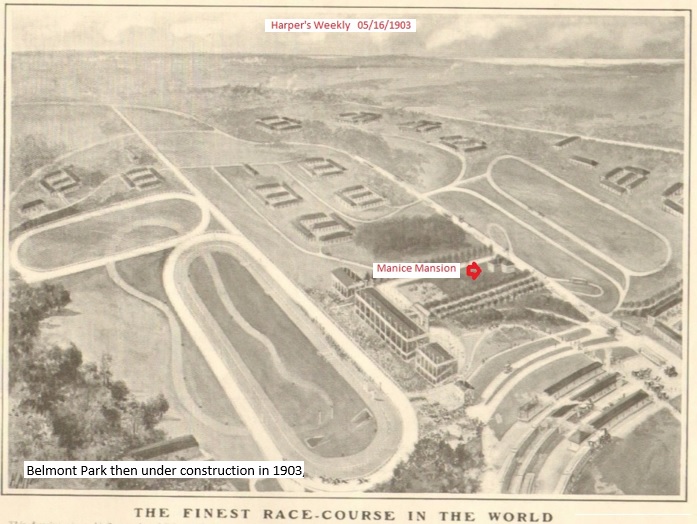
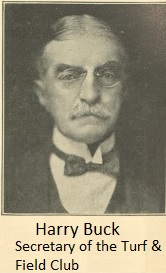
For several years following the election of Charles Evans Hughes as governor of New York, gambling at race tracks was a component of the focus of morality laws, which resulted in horse racing not being conducted during 1911 and 1912. The United Hunts Racing Association, composed mostly of amateur riders, were allowed to compete at the Belmont Park Terminal course, the hunter and steeplechase track on the south side of the Hempstead Turnpike. The United Hunts Racing Association Secretary, Harry A. Buck who was also assistant secretary of the Turf and Field Club, insisted on being arrested to force a test case of the anti-gambling laws. Harry Buck had his roots in journalism, being the son of Col. E.A. Buck, publisher of The Spirit of the Times, the leading sports publication in the 19th Century, and his effort was successful in the courts. Horse racing events resumed in 1913, and Harry Buck was rewarded with his promotion to the post of secretary of the Turf and Field Club, a position he held the rest of his life.
The New York State ban on racing during 1911-12 took a heavy toll on the sport, and a few tracks in Brooklyn were not able to reopen. In the shadow of this short-sighted statewide legislation August Belmont’s four year old gelding Stromboli, the bay son of Fair Play who was foaled during the ban, carried his colors to victory. The New York Sun reported on May 21, 1915,
“Stromboli won the Metropolitan Handicap with the accompanying cheers of 20,000 persons who went to Belmont Park to demonstrate the renewed popularity of the sport which attracts both peer and peasant as no other pastime can.” The same article continued, “The capacity of the Turf and Field Club was tested at the luncheon hour, there being 250 persons, who were seated at tables in the clubhouse, on the veranda and terrace and also on the lawn under the trees.”
The racing patrons that day were treated to a dancing demonstration by celebrity performers Irene and Vernon Castle. The New York Herald reporting the same events added,
“one picturesque feature of former years was missing. There were no warning blasts from ‘yards of tin’ to announce the arrivals of four-in-hands. That absence of a former phase of such a scene as that of yesterday was regretted. The automobile has superseded the road coach and scores of them were parked in the expansive grounds of the club yesterday to make it evident.”
While the United States was embroiled in the First World War, which began spreading a global pandemic, the May 26, 1918 New York Herald reported,
“Coincident with the spring meeting the Turf and Field Club reopened its hospitable doors, and the memory goes back in vain over many years of experience in the social side of race days to recall a similar incident of greater animation or more varied interest. It was decidedly a military scene, which Lander's Band accentuated with its opening march, played under the tall trees of the lawn. It was called ‘For the Freedom of the World’ . . . Accustomed colors in civilian attire were lost in the dominant shades of olive drab of American uniforms, the multiple colors of the British and the horizon blue of the Italian uniforms. More than fifty officers in various branches of the allied service were among the guests at the club luncheon which prefaced the first race.”
During the War, several acts of sabotage occurred on American soil, including a large explosion of munitions barges in New York harbor that caused the original structural damage to the arm and torch of the Statue of Liberty. Additional acts of sabotage occurred at Belmont Park, where several fires where intentional set which unfortunately killed more than two dozen horses and destroyed numerous buildings important to the track’s function. The Manice Mansion was undamaged, perhaps due to its masonry construction, and the Turf and Field Club voted to exempt members serving in the military from paying dues during the conflict, as 20% of their body were in the Army and Navy.

In May of 1920 when the United Hunts Racing Association opened its season, the New York Evening Telegram sent its pioneering female sportswriter Jane Dixon to cover the event. Her reporting mixed racing with the fashion and celebrities at the Turf and Field Club. She wrote,
“It was a striking picture, rainbow radiance of silk and satin and feather fluttering against a background of verdant trees backed with the lacy white of dogwood. And as if this was not rainbow enough, the streak of the riders’ colors as the gentleman jockeys rode their mounts toward the victory post. The blue of a sapphire sea, the crimson on the cheek of a cherry, the gold of an orange nestling in its bower of waxen leaves, the purple of a pansy opening to velvet under the caress of a morning sunbeam- all these flashed around the turfed circle of the club track carrying their wearers to a winner’s warmth of exultation or to the cold balked feeling of an ‘also ran.’”
All homes of a certain age have tales of spirits, and so it was the with the Manice Mansion, where many thought they saw the specter of an attractive young women in stiffened petticoats, half dressed in preparation to attend an important social affair, moving along the stairs and balconies, anxious and determined not to be left out of the merriment.
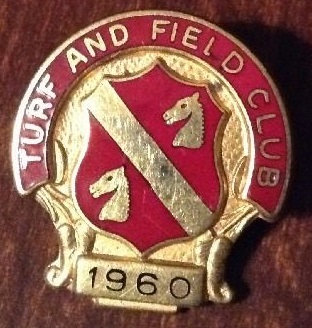
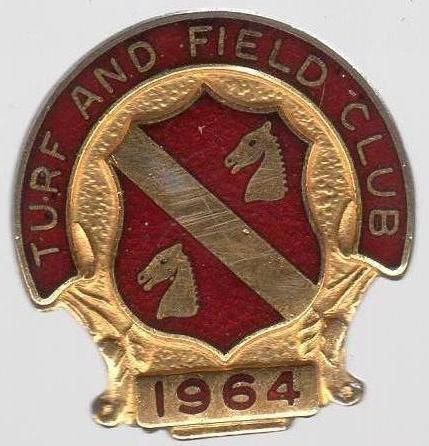
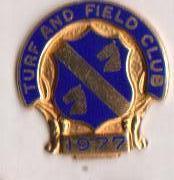
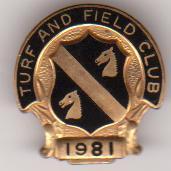
The Long Island Rail Road (LIRR) has always provided a rail connection to Belmont Park, which exists to the present day. The LIRR transported Turf and Field Club members in specially appointed parlor cars, reserved for members only, who were identified by a special badge they wore. Members would gather in the Manice Mansion restaurants and bars, and then move to the saddling paddock along a special tree and flower lined path.
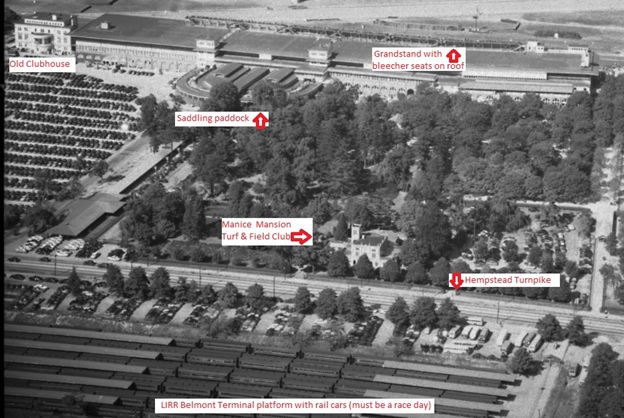
Aerial view of Belmont Park in 1948, and the relationship of various structures.
Opening Day at Belmont Park always created excitement, the May 25, 1923 New York Times described that annual occasion which began with a,
“luncheon at the Turf and Field Club, where there were four hundred reservations. The members of the club and their guests, after luncheon, had only to walk across the paddock to the club’s reserved section of the grand stand, and there was the usual battery of cameras and pencil sketches in black and white to note the parade of fashion. There was nothing daring this year in the first outdoor pageant of fashion except in footwear and ‘nude’ hosiery.”
Similarly on April 26, 1925 the New York Times reported how the luncheon crowd overflowed to the covered verandas on a gray overcast day and,
“a bright feature during luncheon was the parade of mannequins in the very latest robes from Paris but it must be confessed that in spite of the elegance of their attire, they had rather a shivery appearance. This was especially the case with some of the flimsy evening gowns that were shown. The music of the band from the Aquitania entertained the society folk throughout the luncheon."
The Turf and Field Club’s menu and service reputation was legendary, for many years this came under the direction of Jean Malnati, Maître d’hôtel at New York’s Biltmore and several Mediterranean resorts.
The Turf and Field Club, since it was incorporated in 1895 in Westchester County, had always been exactly that, a club run for the benefit of its members, who at that time were less than inclusive in an era when that was accepted. The Club may have become more frigidly exclusive following the death of August Belmont. By this time the Manice Mansion required some updating, the May 15, 1927 New York Times mentioned,
"the Turf and Field Club House which has for several months been undergoing extensive changes under the personal supervision of Joseph E. Widener, President of the Westchester Racing Association." and "the clubhouse, formerly the summer home of the late W. de Forest Manice and the members of his family, was built during the first half of the nineteenth century by a distinguished Frenchman, a close friend to Louis Philippe of France. The structure, with its surrounding grounds, trees and foliage plants, followed the French ideas of that period."
The impressive Edenic gardens were a pleasant manner in which to add a desirable seclusion to the club. The article continued,
"the chief feature is the addition of an octagonal pavilion for luncheon purposes that will seat several hundred persons. From this room there is a view of a small lake on the grounds, with fountains and a great variety of trees, among which is one of the three Cedars of Lebanon known to be in this country."
Mr. Widener, who could always be seen sporting a bowler hat, was a strict adherent to everything British, including the monarchy’s intractable social strata structure.
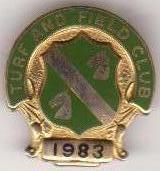
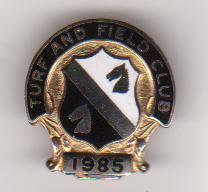
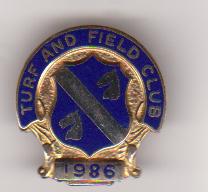
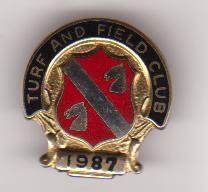
In 1927 the Westchester Racing Association decided to consolidate operations to the north side of the Hempstead Turnpike, and closed the Belmont Park Terminal track and developed the turf and steeplechase course into a housing tract. The Turf and Field Club from that point onward would support only the main track.
During the economic strife of the Great Depression, a charity program was staged at Belmont Park to benefit the Emergency Work Bureau of Nassau County on behalf of the county's unemployed. The June 2, 1932 New York Times stated,
"Racegoers holding enclosure tickets for the day will be extended for the first time the privileges of the Turf & Field Club, including its clubhouse, restaurant and club grand stand." The same article continued with the description of a novel fund-raiser: “An additional feature will be a pony race ridden by former jockeys who are now licensed trainers. The winner of this event will receive a cup donated by the New York Turf Writers."
A visitor and reporter from western New York, Nancy Randolph, visited Belmont Park several times during the 1930’s and left us some firsthand accounts that are interesting to ruminate. In the September 10, 1933 Buffalo Courier-Express she opined,
“the old Manice Mansion is at its best on dour days. There is a cheerfulness in all its rooms that makes lunching a delight. The notables, instead of dashing for their boxes far across the green lawns, linger about the tables set in the nooks and crannies of the famous clubhouse. Right up until the last race, and even after, parties sit at ease, gossiping and smoking and exchanging pleasantries with passing friends. It is all so informal and delightful that I for one, prefer to stay around the clubhouse than go out to the dripping enclosure and watch the poor horses plow through liquid mud.”
The following spring, in the May 27, 1934 edition of the same publication Ms. Randolph wrote,
“we all hike ourselves over the Queensboro Bridge and by way of Long Islands’s dusty town roads to the Emerald Jewel that is Joe Widener’s claim to the benedictions of everyone – Belmont Park. Here we do not immediately go to the track, but saunter across green lawns to the old Manice Mansion, amidst its cedars of Lebanon, with gaily colored umbrellas set against a background of shrubbery, and everyone who was not lunching in town is found lunching here at the Turf and Field. Inside the pleasant rooms are cool and dim, the tables all full. The stairs are crowded and on the second floor, most of the men are visiting at the bar and talking of everything under the sun.” In the same article she continues with more rare insights that “the clothes are simply breathtaking, . . .” and “most everyone is in attendance by the second race. After the fifth society begins to go. The road home is filled with smart cars.”
In the early summer of 1934 Harry Buck, in addition to his continuing role as secretary of the Turf and Field Club, traveled to Europe representing New York racing interests to propose a special contest at Saratoga or Belmont Park involving the American, French and English Derby winners to establish an international three year old champion horse. It is unfortunate this novel international race, which was very forward thinking in the days prior to regular trans-Atlantic air travel, did not materialize.
Perry Belmont, the son of August Belmont and the brother of August Belmont II, who had been involved with New York racing for his entire life and who was 86 years old in 1937 and a past president of the club, made a gift of the original gate from Jerome Park to the Turf and Field Club, where it was prominently installed as the main entrance.
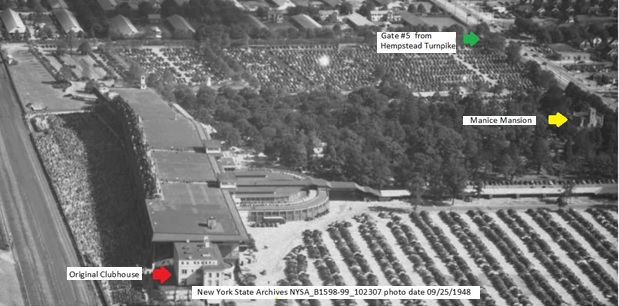
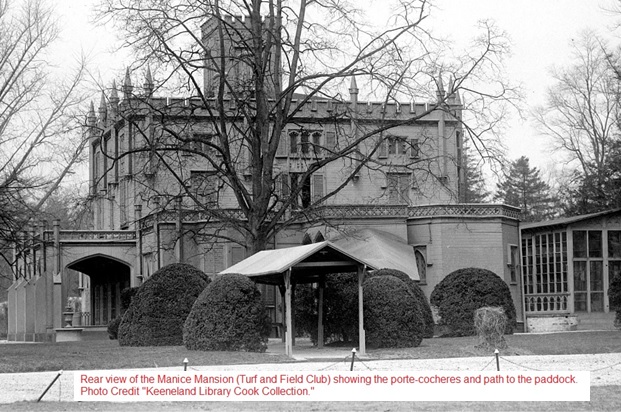
Pari-mutuel wagering did not reach the Empire State until 1940, and the new tote ticket selling and cashier windows gave Belmont Park a different look. There was a single selling-cashier window unit in the Turf and Field Club. Fred Van Ness writing for the New York Times in their May 14, 1940 issue reported,
“It seemed like there were many sightseers more interested in the lawns and elms of the paddock than in picking winners, and this crowd had an added attraction, with the general scene and some of the races televised. . . and these scenes were shown on a receiver in the Turf and Field Club.”
An improvement added in 1941 was a new promenade along the side of the Turf & Field Club, visible to most in the dining area and which was used as a runway for models demonstrating the wares of famous fashion houses between races, and would become known as “the fashion terrace.”
The attack on Pearl Harbor vaulted the United States into the Second World War, and everyone in the nation was shuttled down unexpected paths which had never been anticipated. For three war years 1943-45, the meet dates assigned to the Saratoga Association were conducted at Belmont Park due to travel restrictions preventing use of the upstate track. Military uniforms were in abundance at Belmont Park those summers, but the Manice Mansion was one of the strictures of conflict, and the historic structure was shuttered for the duration. The Turf and Field Club members were relegated to their enclosure trackside, which did include a small restaurant and mezzanine dining room. On August 6, 1943 celebrated New York Times turf writer Bryan Field reported that a series of unpopular disqualifications elicited,
“a succession of catcalls and Bronx cheers such as the Turf and Field Club has never heard.” He continued: “a roar of disapproval greeted the disqualification as the horses went to the post in the next two events, the starter and patrol judges were booed going to their places.” Less than a week later during the Whitney Stakes, when the heavy favorite and Whitney entry Shut Out failed to hit the board, Bryan Field wrote: “the boos which have made the Turf and Field Club resound at this meeting continued.”
In January of 1944 the venerable Harry Buck passed away and Miss W. Helen Eden was appointed to the position of secretary of the Turf and Field Club, a post she would zealously uphold until her death in 1973.
The post-war economic boom that resounded across the country ushered in a return to normalcy and allowed the Turf and Field Club to return to its former eminent location in the old pile. The New York Times on May 6, 1947 mentioned that the Westchester Racing Association was rushing to get things in order and that,
“a corps of workman was sent to the mansion last week.” The same article continued: “members and their guests rolled up to the canopied entrance and as they entered the hall they were amazed at what had been done to the place in so short a time. Pastel blue walls and woodwork, still wet in places, a new cocktail lounge, a new bar in a small circular room – a completely redecorated club greeted the guests.”
Sculptor Herbert Haseltine completed his famous heroic statue of Man o' War in 1948. He began the work several years before, and modeled it from life at Samuel Riddle’s Faraway Farm where the great horse spent his retirement. The plaster original he had created for the foundry to pour the casting from was painted gold and exhibited where ‘Big Red’ won the Belmont Stakes. The May 18, 1948 New York Times described updates at the Manice Mansion to the mezzanine restaurant and the big circular dining room with its large French-style windows and also that,
"Turf and Field Club members bearing their badges were allowed inside the enclosure to get a close-up of the statue."
The decade of the 1950’s introduced a new event, the Belmont Ball, scheduled for the evening before the annual running of the Belmont Stakes, with a New York charity to benefit. Exciting fundraising auctions were staged during the Ball, where furs, jewelry by Van Cleef and Arpels and also Cartier, clocks by Black, Starr & Gorham, a miniature Crosley automobile and spirits donated by caterer Harry M. Stevens were sent to the block. Other interesting auction items were table-top bronzes of past Belmont Stakes winners by the sculptor June Harrah Lord, and a plate un-shoed from the next day’s Belmont Stakes winner. Celebrity auctioneers helped stoke the bidding interest, and they were frequently drawn from the press-box, with turf writers such as Joe Palmer and Red Smith delivering the chant. The May 31, 1952 event was reported by the Daily Racing Form,
“This festive affair, held partly in the Manice Mansion, the miniature chateau adjoining the Belmont paddock which is headquarters of the Turf and Field Club, and partly under canopies outside” where an orchestra was staged and a dance floor constructed.
The middle years of the 1950’s saw a paradigm shift at Belmont Park just as the racing plant was reaching its golden anniversary, when a new management group took charge. The New York Times on May 15, 1956 reported,
“A better-than-usual attendance of society members was present yesterday afternoon at the opening spring race meeting of the Greater New York Association, Inc. at Belmont Park. There were many changes in the old park at which the Westchester Racing Association has sponsored spring and fall programs for years. Many members of the Turf and Field Club, who had expected to have luncheon in the historic Manice House, as usual were routed across the turf and through the gardens to the enclosure at the tracks.”
The Greater New York Association, which would soon relabel itself the New York Racing Association (NYRA) had no future plans that included the Manice Mansion. The Turf and Field Club had lost their home.
Planned changes at Belmont Park following the 1956 season included demolishing the original trackside clubhouse, which was located when races were originally run clock-wise, and moving the LIRR terminal north of Hempstead Turnpike, with a pergola connecting the new train station to the grandstand across this location. Also planned were new exit/entrance ramps linking the Cross Island Parkway and Hempstead Turnpike with grade separated crossings, and additional parking. George F.T. Ryall, the long-time turf writer for the New Yorker magazine wrote in his ‘The Race Track’ column in the December 15, 1956 edition,
“some of the trees will be transplanted, the house will be torn down, and the grounds will be turned into a parking lot, or something. There is scarcely anyone around Belmont who doesn’t deplore the passing of the Manice Mansion. It has been a wonderful place.”
With palatable regret, William R. Conklin reported in the January 25, 1957 edition of the New York Times,
“Blueprints and bulldozers combined yesterday to push Old Belmont Park’s historic landmarks into oblivion in the name of progress. The 175-year-old Manice Mansion where Louis Phillippe I, King of France, spent part of his exile is being steel-balled into rubble. The baroque dwelling acquired by Belmont Park in 1904 was the original home of the Turf and Field Club, organized in 1895.”
The Turf and Field Club continued on, with locations at both Aqueduct and Belmont Park after the Manice Mansion had been consigned to history.



